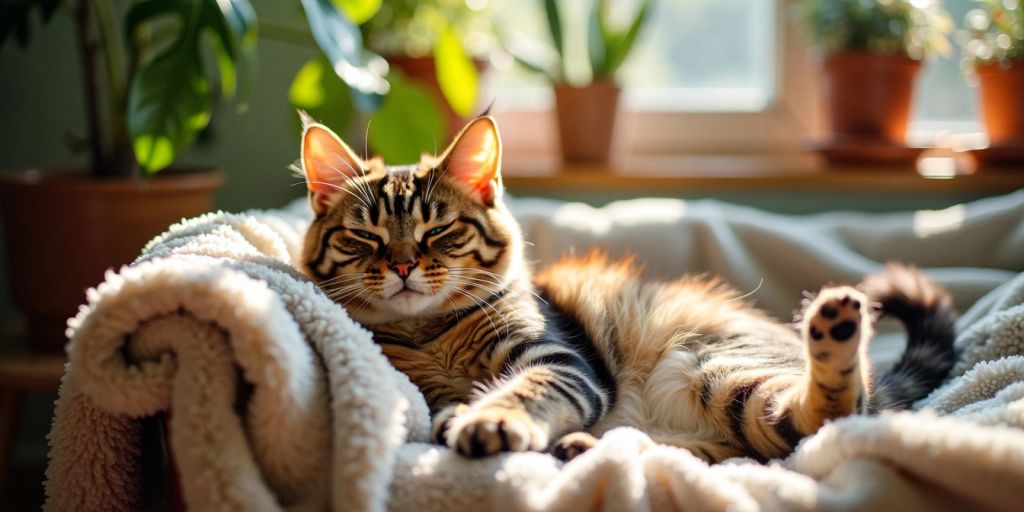Caring for a cat can be a rewarding experience, but it’s important to do it right to ensure your furry friend is happy and healthy. This guide will provide you with practical tips and advice on how to create a stress-free environment, nurture their emotional well-being, and maintain their overall health. Whether you’re a new cat owner or someone looking to improve their cat care routine, these insights will help you provide the best for your feline companion.
Key Takeaways
- Create safe spaces for your cat to relax and feel secure.
- Pay attention to your cat's behavior to spot signs of stress.
- Feed your cat high-quality food and set regular feeding times.
- Keep your cat groomed to reduce shedding and hairballs.
- Engage in playtime to keep your cat active and happy.
Creating A Stress-Free Environment
Cats are very sensitive creatures, and their surroundings can greatly affect their mood. Creating a safe and secure space for your cat is essential for their happiness. Here are some key points to consider:
Understanding Your Cat's Sensitivity
- Cats can easily become stressed by changes in their environment.
- It's important to recognize that they thrive in familiar settings.
- Limit changes to their space to help them feel secure.
Providing Safe Spaces
- Ensure your cat has multiple hiding spots and climbing areas.
- Consider using cat trees or shelves to give them vertical space.
- Provide cozy beds or blankets in quiet corners where they can retreat when needed.
Maintaining Familiarity
- Keep your cat's food bowls, litter boxes, and toys in the same locations.
- If you need to move items, do it gradually to help them adjust.
- Establish a consistent routine for feeding and playtime to foster a sense of security.
By following these strategies, cat owners can foster a happy and harmonious relationship with their pets.
Creating a stress-free environment is not just about physical space; it’s about understanding your cat’s needs and ensuring they feel safe and loved.
Nurturing Your Cat's Emotional Well-Being
Cats have feelings just like we do! Taking care of their emotional needs is just as important as their physical health. Here are some ways to help your cat feel happy and secure:
Recognizing Stress Signals
- Look for signs like hiding, excessive grooming, or changes in eating habits.
- Pay attention to their body language; a twitching tail or flattened ears can indicate stress.
Engaging in Interactive Play
- Spend time playing with your cat using toys that mimic hunting, like feather wands or laser pointers.
- Schedule daily play sessions to keep them active and mentally stimulated.
Building Trust Through Routine
- Cats thrive on routine. Try to feed, play, and groom them at the same times each day.
- Consistency helps your cat feel safe and secure.
Remember, a happy cat is a healthy cat! Taking the time to nurture their emotional well-being can lead to a more fulfilling life for both you and your feline friend.
| Stress Signals | Description |
|---|---|
| Hiding | Seeking a safe space |
| Excessive Grooming | Over-grooming can indicate anxiety |
| Changes in Eating | Loss of appetite or overeating |
Ensuring Proper Nutrition For Happiness
Choosing High-Quality Food
Cats are obligate carnivores, which means they need a diet rich in high-quality protein. When selecting cat food, look for options that list meat as the first ingredient. Avoid foods with fillers like corn or soy. Here’s a quick comparison of wet and dry food:
| Type of Food | Benefits | Drawbacks |
|---|---|---|
| Wet Food | High moisture content, great for hydration | Can be more expensive, may spoil quickly |
| Dry Food | Convenient, helps with dental health | Less moisture, may lead to dehydration |
Establishing Feeding Routines
Creating a consistent feeding schedule can help your cat feel secure. Here are some tips:
- Feed your cat at the same times each day.
- Measure portions to avoid overfeeding.
- Consider using puzzle feeders to make mealtime engaging.
Addressing Special Dietary Needs
Some cats may have specific dietary requirements due to health issues. Always consult your vet if you notice any changes in your cat’s eating habits or if they need a special diet.
A balanced diet is essential for your cat's overall happiness and health. Make sure to monitor their food intake and adjust as needed to keep them thriving!
Grooming Practices For A Happy Cat
Keeping your cat well-groomed is essential for their health and happiness. Regular grooming helps prevent matting and reduces shedding, making your home cleaner and your cat more comfortable.
Regular Brushing Techniques
- Frequency: Brush your cat at least once a week. Long-haired cats may need daily brushing.
- Tools: Use a slicker brush for tangles and a bristle brush for finishing touches.
- Technique: Start at the head and work your way down, being gentle around sensitive areas.
Managing Shedding and Hairballs
- Diet: Ensure your cat is eating high-quality food to promote healthy skin and fur.
- Hydration: Encourage drinking water to help with digestion and reduce hairballs.
- Regular Grooming: Frequent brushing can significantly reduce shedding and hairballs.
Nail Care Essentials
- Tools Needed: Use cat nail clippers or a human nail clipper.
- Frequency: Trim nails every 2-4 weeks.
- Technique: Hold your cat's paw gently and press the pad to extend the nail. Cut just the tip, avoiding the quick (the pink part).
Regular grooming not only keeps your cat looking good but also strengthens your bond with them. It’s a great way to check for any skin issues or lumps that may need attention.
By following these grooming practices, you can ensure your cat stays happy and healthy!
Creating Engaging Playtime Activities
Selecting The Right Toys
Choosing the right toys is essential for keeping your cat entertained. Here are some popular options:
- Wand toys: Great for interactive play and mimicking hunting.
- Puzzle toys: Stimulate your cat's mind and reward them with treats.
- Catnip toys: Many cats love the smell of catnip, making these toys a hit.
DIY Play Ideas
You don’t need to spend a lot on toys! Here are some fun DIY ideas:
- Paper balls: Crumple up paper into a ball for a simple toy.
- String and feather: Attach feathers to a string for a homemade wand toy.
- Box forts: Cats love to explore, so create a fort with cardboard boxes.
Incorporating Exercise Into Play
Regular playtime helps keep your cat healthy and happy. Aim for at least 15-20 minutes of play each day. Here are some tips:
- Use toys that encourage jumping and running.
- Rotate toys to keep things fresh and exciting.
- Schedule play sessions at the same time each day to build a routine.
Engaging your cat in play not only reduces boredom but also strengthens your bond. It’s a win-win for both of you!
Maintaining A Clean Litter Box
Keeping your cat's litter box clean is essential for their comfort and health. Cats prefer a clean area to do their business, so regular maintenance is key. Here are some important tips to ensure your cat's litter box stays fresh:
Choosing The Right Litter
- Opt for clumping litter, as it makes cleaning easier.
- Consider your cat's preferences; some may prefer clay, while others like natural options.
Placement Tips For Litter Boxes
- Place the litter box in a quiet, low-traffic area.
- Ensure there are enough boxes—one for each cat plus one extra.
- Avoid placing the box near food and water bowls.
Troubleshooting Litter Box Issues
- If your cat refuses to use the box, check for cleanliness. Scoop waste daily.
- If problems persist, consider changing the type of litter or the box itself.
Regular cleaning is crucial. Wash the litter box monthly with water and a mild detergent to keep it odor-free and inviting for your cat.
Socializing Your Cat Effectively
Introducing New Pets
When bringing a new pet into your home, it’s important to take things slow. Start by keeping them in separate rooms. Allow them to sniff each other’s belongings to get used to each other’s scents. Building trust is the foundation of any successful cat socialization. Spend time in the same room as the cat without directly interacting with them. This helps them feel safe and reduces anxiety.
Gradual Exposure To New Environments
Cats can be sensitive to changes in their surroundings. Introduce them to new spaces gradually. Start with short visits to new areas of your home, and reward them with treats for calm behavior. This can help them feel more comfortable and confident in unfamiliar settings.
Positive Reinforcement Techniques
Using positive reinforcement is key to effective socialization. Here are some techniques:
- Treats: Reward your cat with their favorite treats when they display calm behavior around new pets or environments.
- Praise: Use a gentle voice to praise your cat when they explore new areas or interact positively with others.
- Playtime: Engage your cat in play after they’ve successfully met a new pet or explored a new space. This reinforces positive experiences.
Remember, patience is essential. Each cat is unique, and some may take longer to adjust than others.
By following these steps, you can help your cat become more social and comfortable in various situations, leading to a happier and more relaxed feline friend.
Final Thoughts on Stress-Free Cat Care
Taking care of your cat can feel like a big job, but it doesn't have to be hard. With the right tips and tools, anyone can be a great cat owner. This guide has shared useful advice on how to keep your cat happy and healthy, from what they eat to how you play with them. Remember, every cat is different, so pay attention to what your furry friend likes and needs. By following these tips, you can help your cat live a long, joyful life.
Frequently Asked Questions
How can I tell if my cat is stressed?
Look for signs like hiding, changes in eating habits, or excessive grooming. Cats may also vocalize more or seem restless.
What should I do if my cat doesn’t like their litter box?
Try changing the type of litter, moving the box to a quieter place, or ensuring it’s clean. Some cats prefer covered boxes, while others like them open.
How often should I groom my cat?
Most cats benefit from weekly brushing, but long-haired breeds may need it more often to prevent mats and tangles.
What type of food is best for my cat?
Choose high-quality cat food that lists meat as the first ingredient. Wet food can help with hydration.
How can I make my cat feel safe at home?
Create hiding spots with boxes or blankets and keep their environment stable. Avoid sudden changes.
Is it normal for my cat to be picky about toys?
Yes, cats can be particular about toys. Experiment with different types to find what your cat enjoys most.



